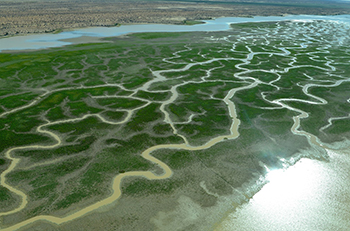Named for an English audience after the explorer Edward John Eyre, who first sighted it in 1840, Australia’s Lake Eyre is still one of the natural wonders of the world. Not for thirty years would the lake’s expanse be determined, and was 113 years before the site would be renamed Kati Thander, the sacred Aboriginal name for its more common characteristic, a flat salt pan. Showing how dry and hard it can be, it was chosen in 1964 as the site for Donald Campbell’s successful world land-speed record (of 403mph) in his wheel-driven Bluebird.
The traditional name refers to “how the lake was formed after the skin of a kangaroo was spread over the ground”.
When full, it is one of the largest inland seas in the world as well as being the lowest natural point in Australia at 15 metres below sea level. On the rare occasion when totally full - a major flood may occur about every eight years - it covers 9,500 square kilometers. The feeder rivers such as Warburton Creek, Cooper Creek and Diamantina River from Queensland’s Channel Country turn the whole basin into a vast wetland.
Thousands of pelicans, silver gulls, banded stilts and other water birds seem to know where the fish are in abundance and flock to the lake. No doubt some come from the shores of our own region. Freshwater fish are carried in with the flood, while brine shrimp hatch and vegetation sprouts.
Like the migratory birds, we flew in to find the lake about two-thirds full, although the water flowing in is about equal to the evaporation rate, so it won’t fill further until there is more heavy rain.
In late January and early February this year an intense and slow moving monsoonal low over north Queensland caused record breaking rain and disastrous flooding. This was Cyclone Trevor and in March there was further rain over a broad region of central and southwestern Qld and adjacent areas of the NT.

To see what all this may look like from the air a group of ten of us from the Northern Rivers set off from Lismore on an excursion to Kati Thander-Lake Eyre. The pilot and guide was Kirk Campbell and co-pilot Lismore GP cum aviator Isaac Flanagan.
From Lismore Airport we flew low over the Great Divide then over some of the bare drought stricken land of the Darling Basin. We finally landed on a dirt airstrip at a large sheep and cattle property called Charlotte Plains Station. Here we were met by the delightful owner Robyn Russell, aged 74, who had many outback stories to tell. Lunch was served on the homestead verandah.
She gave us startling statistics of the fraction of the number of sheep and cattle now on the property in these times of drought. However tourism is helping to fill the gap in revenue and more people venture to this great station attracted by the woolshed, landscape, outback culture and the artesian basin with open-air hot baths.
We went on to the famous Dig tree of Burke and Wills fame before a night at the Innamincka Hotel. The visit next morning to Burke’s grave was very informative. There are a few varied stories about the timing of his death on the banks of Cooper Creek, but it seems he may have survived if he’d had a better relationship with the local Aboriginal people and their knowledge of bush tucker.
Then it was a low-level flight from south to north over Kati Thander-Lake Eyre. This was an amazing sight of the vast sea, with flocks of pelicans. The colour of the water varied with the depth and wind factors. The shores were varying colours alongside the vast carpet of green landscape with capillary-like creeks.
Cattle were abundant and well fed. One couldn’t help feeling for the Queenslanders who lost all their stock in the severe flooding. And then there were those further south who have lost out with the drought of the Darling Basin.
Before a final night at the famous Birdsville pub, we went to the Big Red at sunset, red sand hills popular with 4WD drivers in their attempts to drive up. Nearby there is a valley that is the site of the Big Red Bash Music Festival, which this year featured Midnight Oil. This and the annual race day swell the population of Birdsville from 120 to tens of thousands.
The trip back home included a stop for lunch at Charleville’s classic Hotel Corones with its art deco features, and a visit to the Royal Flying Doctor base, with jokes that is where Dr Isaac Flanagan belongs.
The water will remain in Kati Thander-Lake Eyre until about September before the long process of evaporation takes it back to being a dry salt lake again, until the next phase in the cycle of this extraordinary place.
















